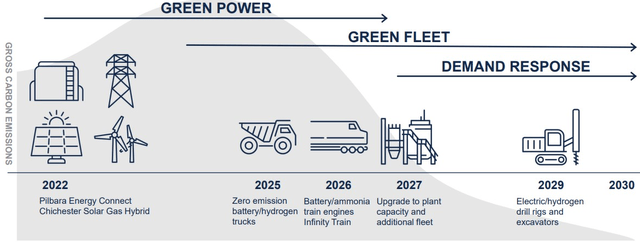Enes Evren
We have recently focused on players in the materials space due to the value investment opportunities we see in these areas, as well as the relative confidence we have in understanding these businesses. Simultaneously, we have been seeking potential market leaders for the global energy transition, as we feel it is an investment theme with huge upside potential.
Fortescue Metals (OTCQX:FSUMF), as the world’s fourth-largest iron ore provider, and with its industry-leading decarbonization plan, fits the mold. However, we find valuing the company in its current state a particularly challenging proposition.
The Company
Fortescue’s core business is its Western Australia-based fully integrated iron-ore producing operations, ranging from mining and processing, to rail and port facilities. Australia is the world’s largest exporter of iron ore, and together with BHP (BHP) and Rio Tinto (RIO), the company has in the last decade benefitted enormously from China’s insatiable demand for the commodity.
In 2018, the company made a significant pivot in setting up Fortescue Future Industries (‘FFI’), a nascent business that is focused exclusively on renewable energy projects. As a group, the company is aspiring to real zero Scope 1 and 2 emissions by 2030 and net-zero Scope 3 by 2040, which are aggressive, industry-leading ambitions. The company is banking on technological advances and execution by FFI to achieve these goals.
The key initiatives behind Fortescue’s ambitious plan for zero emissions by 2030 (Company Presentation)
The core metals business is also looking to FFI innovations to improve its financial performance. It has highlighted initiatives such as a regenerating battery electric iron ore train, and zero emission haul trucks as a way for it to decrease its costs through less diesel consumption. In its most recent quarterly update, management referenced expected $3bn in savings during the commissioning stage to full decarbonization, and $800m savings in operating costs annually subsequently.
As an observer of investor and analyst calls, we noted that management spent the majority of the time addressing the growth opportunities in FFI, and it was clearly telegraphed to us that decarbonization projects are the primary focus of the company, with iron ore production relegated to business-as-usual status.
The Financials
Despite the emphasis and substantial progress touted by management, ultimately the FFI division has yet to generate revenues, against a cost base of almost $400m in FY2022. Forecasted expenditure for FFI is $600-700m for FY2023, with $100m designated as capex and the remainder as operating expenses.
Despite the hype, FFI has not yet generated any revenues during its existence (FY2022 Annual Report)
Admittedly, this is a small change for a company which generated $17.4bn in revenues and $6.2bn in net profits (inclusive of FFI losses) in 2022. The company also paid out 75% of NPAT as dividends, which amounts to $4.3bn. Collectively, Fortescue’s setup to generate substantial profits and pay out healthy dividends makes it unique in having both characteristics of a speculative growth company, and an old economy business.
Where we see its financial standings differ to a more traditional materials producer is in its debt portfolio. Despite coming off the two most profitable years in the company’s history, in 2022 the company increased its long-term borrowings to $6.1bn, including raising $800m from a green bond issuance. Its gross gearing ratio of 26%, although below the internal target of 30-40%, is an unsettling level. This contrasts with old economy peers such as South32 (OTCPK:SOUHY) (12%), Woodside (WDS) (14%), and Rio Tinto (19%), which have generally looked to bring down their debt levels after benefitting from profitable business conditions in the last few years.
On the back of an $800m green bond issuance, Fortescue has bucked the trend and increased their debt liabilities (Company Presentation)
Because of the growth strategy being pursued, the elevated debt levels are unsurprising, although it could be construed that Fortescue is actually borrowing to fund shareholder returns. We see this straddle in maintaining dividend payouts commensurate to industry standards, whilst taking on more debt to fund growth, as a dilemma management is struggling to deal with.
Valuations
Trading at 6-7x earnings and around 2.5x book value, valuations are within the industry’s market range (e.g., Rio Tinto trades at P/E 6-7x, P/B 2.3; South32 at P/E 4-5x, P/B 1.1; Woodside at P/E 7-9x, P/B 1.5). To be fair, the comparisons provided are not like-for-like because only Rio Tinto has an iron ore business. But broadly speaking, we think all these businesses can be bifurcated into core operations, and a growth business (loosely described as diversification into production of future-facing commodities).
If there was any alpha Fortescue had over the comparisons selected, we think it would lie within FFI vs the growth strategy of the others. The current levels the stock finds itself trading at suggest that investors don’t find Fortescue’s business model any more attractive than alternative offerings in the raw materials universe. If investors were genuinely concerned about future cash burn from FFI, we would have expected valuations to be much cheaper; conversely, if investors were particularly bullish about FFI’s prospects, we would have expected valuations to be much higher.
For us as value investors, with no clear indication as to when FFI will generate its first revenue, let alone turn a profit, we are out of our depth in trying to attribute a valuation to this business. On the contrary, we’re mildly wary of the risk that an overrun on the spending required to get FFI commercially viable could result in the cutback of dividend payments, the accumulation of further debt, and perhaps a worst-case scenario of additional capital raising having a dilutive effect on existing shareholders. We note that non-executive chairman Andrew Forrest made a passing comment during an analyst call that FFI could be valued around $20bn; at this juncture, we would attribute no value (positive or negative) to the division.
I have not ever tried to value the company (FFI), but I’ve had expressions of interest made to me by fund managers, by big infrastructure managers. They’ve talked around US$20 billion. (Andrew Forrest, FY22 Annual Results analyst call)
Returning back to the core iron ore business, the recent tailwind that was the China growth story appears to have subsided substantially. In its absence, we do not see a clear catalyst that will sustain strong future demand, although we acknowledge likely positive second-order effects from the buildout of green infrastructure globally. Furthermore, we think the demand for Fortescue’s core offerings from Chinese customers may be weakened by the eventual production ramp-up out of Simandou, although we don’t see global supply to be affected substantially enough for it to have a structural effect on iron ore prices. Broadly speaking we assume future prices for iron ore to remain stable, but over the long run, we look for it to underperform more forward-facing commodities such as copper, nickel, and lithium.
Final Thoughts
For investors with venture capital-like enthusiasm and mindset, Fortescue may offer an attractive opportunity, with the iron ore business acting like a buffer in generating positive cash flows and dividends while waiting for the growth arm to generate revenues and eventually profits.
We are not so cavalier with our investment approach and can only value the more certain part of the business, which is as an iron ore producer. With a lack of conviction on the future price of iron ore, operating costs for FFI a negative drag on overall earnings, and concerns about adequate capital to fund FFI on its path to profitability, we see uncertainty in Fortescue’s future trajectory. Despite this, we observe that the stock is priced at around par for the industry, and therefore feel the investment risk-reward paradigm is negatively skewed.
We like the ambition and direction of Fortescue’s decarbonization project generally, though, and are looking forward to revaluing FFI when revenues are eventually achieved. We will be also keeping an eye on developments at Simandou, as although production is not imminent, we think Fortescue’s standing could be adversely impacted.
(Reported $ amounts reference USD as the reporting currency of Fortescue)
(AUDUSD=0.67 assumed in analysis)


Be the first to comment